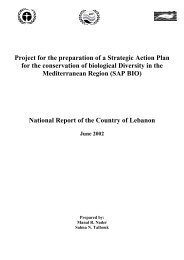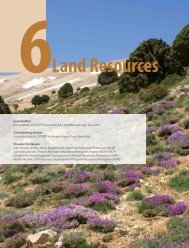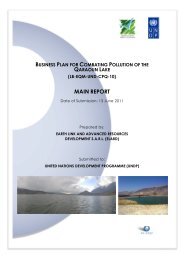Biodiversity and Forests
Biodiversity and Forests
Biodiversity and Forests
Create successful ePaper yourself
Turn your PDF publications into a flip-book with our unique Google optimized e-Paper software.
<strong>and</strong> evaluation of plant genetic resources is<br />
mostly limited to morphological descriptors <strong>and</strong><br />
agronomical traits. It has been applied so far to<br />
l<strong>and</strong>races <strong>and</strong> improved varieties of fruit trees,<br />
field crops <strong>and</strong> some vegetables. Molecular<br />
characterization has only been applied to a<br />
limited number of crops using European funds.<br />
Financial <strong>and</strong> technical support is needed to<br />
exp<strong>and</strong> plant genetic resources characterization<br />
<strong>and</strong> evaluation by using advanced techniques<br />
<strong>and</strong> by strengthening skills <strong>and</strong> adopting<br />
adequate equipments.<br />
Only few breeding activities have been carried<br />
out in Lebanon. They are limited to wheat, barley,<br />
chickpea <strong>and</strong> lentil. Regarding fruit species,<br />
breeding activities are restricted to some clonal<br />
selection activities that have been recently<br />
conducted for stone fruits <strong>and</strong> grapevines.<br />
There is an urgent need to establish a national<br />
strategy for the breeding <strong>and</strong> improvement of<br />
the Lebanese plant genetic resources for target<br />
crops (Chalak et al., 2011).<br />
5.6.2 Formulating a National Forest Policy<br />
<strong>and</strong> Strategy<br />
The National Reforestation Plan <strong>and</strong> National<br />
Strategy for Forest Fires should be integrated<br />
into a broader <strong>and</strong> much needed National<br />
Forest Policy <strong>and</strong>/or National Forest Strategy.<br />
This is particularly needed for sensitive forests<br />
(e.g., cedars, junipers) which could be affected<br />
by climate change in a topographical corridor<br />
determined by bioclimatic zones, <strong>and</strong> for<br />
communal forests near villages <strong>and</strong> towns. The<br />
strategy would need to address the scattered<br />
efforts at reforestation <strong>and</strong> l<strong>and</strong> restoration,<br />
<strong>and</strong> strengthen their technical aspects. It would<br />
also provide management tools <strong>and</strong> incentives<br />
to prevent forest fragmentation, ensure habitat<br />
conservation <strong>and</strong> conserve environmental<br />
services. In the absence of strategies <strong>and</strong> action<br />
plans that encourage citizens <strong>and</strong> decisionmakers<br />
to become better stewards of their<br />
l<strong>and</strong>scape, today’s piecemeal efforts to conserve<br />
the nation’s forests <strong>and</strong> their biodiversity will<br />
not achieve sustainable results.<br />
Equally important, the decade long contention<br />
between the ministries of Environment <strong>and</strong><br />
Agriculture over their respective forest <strong>and</strong><br />
protected area m<strong>and</strong>ates must be resolved.<br />
Their overlapping responsibilities must be<br />
streamlined. Each ministry alone cannot protect<br />
<strong>and</strong> develop forest resources. Their combined<br />
resources <strong>and</strong> approaches will help ensure a<br />
conservation ethic <strong>and</strong> reforestation program<br />
that is compatible with rural development<br />
needs.<br />
5.6.3 Challenges <strong>and</strong> Opportunities for<br />
Sustaining Lebanon’s Protected Areas<br />
With the exception of nature reserves, most of<br />
which have well established management plans,<br />
all other protected areas need management<br />
<strong>and</strong> monitoring. The number of protected areas<br />
<strong>and</strong> their coverage can be misleading indicators<br />
of conservation (especially for marine areas), as<br />
their establishment is not necessarily followed<br />
by effective management <strong>and</strong> enforcement of<br />
regulations (Mora et al. 2006, Rodrigues et al.<br />
2004). Stated differently, measuring the number<br />
<strong>and</strong> extent of protected areas only provides a<br />
uni-dimensional indicator of Lebanon’s (political)<br />
commitment to biodiversity conservation. There<br />
is a growing need therefore to also develop<br />
indicators on the effectiveness of conservation<br />
activities, including PA management. Such<br />
indicators will generate data that may be<br />
included in the World Database of Protected<br />
Areas, <strong>and</strong> help countries assess progress<br />
towards meeting global biodiversity targets.<br />
The GOL needs to show greater commitment<br />
on several PA fronts. It should approve the<br />
draft Framework Law for Nature Reserves<br />
without further delay. This law (1) defines the<br />
management objectives of nature reserves,<br />
(2) regulates the establishment of nature<br />
reserves on private l<strong>and</strong>s, (3) outlines the<br />
management structure of nature reserves<br />
<strong>and</strong> formally recognizes APACs, (4) addresses<br />
financing mechanisms, (5) allows APACs to<br />
charge admission fees <strong>and</strong> impose fines in case<br />
of violations, <strong>and</strong> (6) uses zoning to encourage<br />
sustainable use of natural resources inside the<br />
nature reserve. Building on this draft Framework<br />
Law, the COM must endorse without delay the<br />
draft PA Category System which defines PA<br />
categories <strong>and</strong> scientific criteria <strong>and</strong> guidelines<br />
for PA designation. MOE has also prepared a<br />
draft decree on the roles <strong>and</strong> responsibilities of<br />
PA management staff. Finally, the GOL should<br />
also formally declare Lebanon’s first national<br />
park (the Akkar-Hermel-Dinnieh intersection),<br />
already identified in the National L<strong>and</strong> Use<br />
Master Plan which was enacted by the Council<br />
of Ministers in 2009.<br />
5.6.4 Upscaling Ecotourism <strong>and</strong> Other Forms<br />
of Low Impact Recreation<br />
Nature <strong>and</strong> culture tourism are important<br />
activities <strong>and</strong> sources of income to villages<br />
<strong>and</strong> towns near protected areas <strong>and</strong> all along<br />
the Lebanon Mountain Trail (Box 5.7). Because<br />
this sector is growing <strong>and</strong> gaining recognition<br />
among municipalities <strong>and</strong> tour operators, it<br />
is important to develop environmental <strong>and</strong><br />
Chapter 5: <strong>Biodiversity</strong> <strong>and</strong> <strong>Forests</strong> 171





